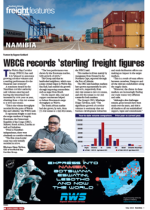It also has the potential to supply gas to the region.“The planned green hydrogen industry for Namibia is a long-term and technologically challenging initiative. When it goes ahead, there is enough power to be generated through wind and solar to drive the necessary electrolysis process required for the ammonia production to be transported to Europe. “Consider then that Europe is promoting a drive to green-steel production but doesn’t have the necessary green energy resources to support the existing steel production sector, especially in Germany. Then an export picture starts to emerge that could fundamentally alter the economic complexion of Namibia.”The emerging oil and gas sector could be seen as a facilitator to ensure investment into the energy transition from hydrocarbons to renewable resources over time – including the green hydrogen initiative.As for the current cargo picture at the Port of Walvis Bay, Pretorius said it must be remembered that the need for commodities probably exceeds the supply by a large margin.This is particularly true if one wants to meet the energy transformation target dates.“New mines or capacities must be increased to sustain the energy transformation targets. Most likely, bigger volumes out of the Copperbelt are such that there will always be spill-over freight to an uncongested port like Walvis.“What’s more, if the port’s draught is deepened to 18 metres, and the approach channel widened from 150m to 185m with a larger turning basin, we could become a port of destination for your larger cargo vessels.“So no, I don’t think Namibia should feel threatened by what’s happening in Angola and its potential to take copper outf lows away from us,” Pretorius said.“Indications are that our energy sector and green hydrogen will sustain our logistics industry well into the future.” From page 24

